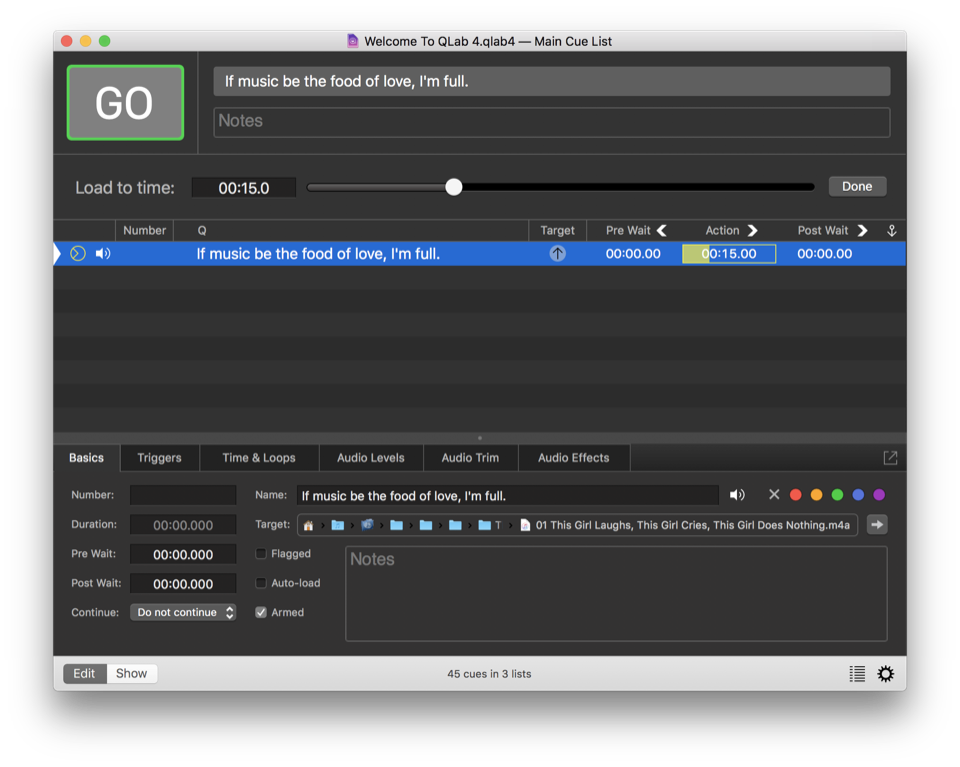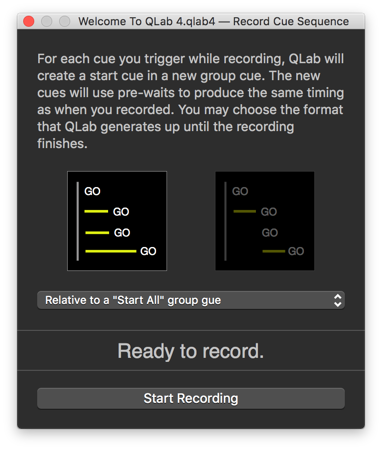The Tools Menu
The Tools menu contains items relating to workflow, which is to say the process of building cues and cue sequences and operating QLab. The menu is context-sensitive, and can display different tool when different windows in QLab are active. When a cue list or cart window is active the Tools menu shows its default set of items.
Load To Time
The Load to Time tool allows you to scrub through the standing-by cue (or cue sequence) to a particular time before starting the cue. Then, when the cue is started, it will begin playing from that time. For example, if you are rehearsing a bit of your show that happens thirty seconds into the start of a cue, you can load that cue to 0:30 and then start it right at the moment you want to rehearse.
To access this feature, select Load to Time from the Tools menu, or use the keyboard shortcut ⌘T. Load to Time is one of the tools that occupies the toolbar, and selecting the menu item or using the keyboard shortcut cycles the toolbar through three states:
- When the Load to Time tool isn’t displayed, the command will display it.
- When the Load to Time tool is displayed but the cursor isn’t in its text box, the command will move it there.
- When the Load to Time tool is displayed and the cursor is in the text box, the command will close the Load to Time tool and move focus back to the cue list.
To use the Load to Time tool, type a number into the text field or drag the slider along the timeline to load the selected cue or cue sequence to your desired time.
If you type a negative value into the field, QLab will load to that amount of time back from the end of the cue or sequence, if possible.
Cue Numbering
Renumber selected cues (⌘R). This will renumber all of the currently selected cues. You will be prompted to enter a starting number and an increment value. QLab will skip any cue numbers belonging to other, non-selected cues in the workspace.
Delete numbers of selected cues (⌘D). This will delete the cue numbers of all selected cues. This will not alter cue targets or anything else at all, just the cue numbers.
Jump
Jump to cue… (⌘J). This lets you quickly move the selection to a specific cue. You’ll be prompted to enter a cue number. Note that if the playhead and selection are locked together, the playhead will also move. If they are unlocked, only the selection will move.
Jump to selected cues’ targets (⇧⌘J). When the cue or cues that are selected target other cues in the workspace, this will move the selection to those target cues.
Record Cue Sequence…
The sequence recorder tool allows you to play through cues by hand, and have QLab record your timing. When you stop recording, QLab will create a Group cue filled with Start cues, each triggering the cues that you triggered with pre-waits that exactly match your timing.
To do this, choose Record cue sequence… from the Tools menu. Then, choose whether you want to create a Group cue set to “start all children simultaneously” with pre-waits on the Start cues, or a Group cue set to “start first child and go to next cue” with pre-waits and auto-continues on the Start cues. Then, click Start Recording and run the cues that you want to include in the sequence.
When you’re done running your cues, click Stop Recording. QLab will create the new Group cue, full of Start cues, below the selected cue. Your original cues remain untouched. If you want to re-record the sequence, simply delete the new Group cue and try the process again. If you like the sequence and want to use it in your show, you can move the original cues into another cue list to keep them out of the way. It’s important to remember that they cannot be deleted, however, since the sequence is made up of Start cues which trigger the original cues.
Live Fade Preview
When live fade preview is turned on, any adjustments you make in a Fade cue will be immediately reflected, as long as the Fade cue’s target is playing. So, if you play an Audio cue, and then create a Fade cue targeting that Audio cue, any adjustments you make in the Fade cue will be audible.
When live fade preview is turned off, you can make adjustments to a Fade cue without hearing or seeing those changes until you run the cue. This can be helpful while building cues in rehearsal, to allow you to run an Audio or Video cue for the performers to work with, and then prepare a Fade cue without disturbing them.
Highlight Related Cues
When Highlight related cues is turned on, QLab will highlight all cues which target or which are targeted by the selected cue. QLab uses a grey highlight for related cues, to distinguish from the regular highlight color as well as the yellow highlight color used by the Find tool.
Black Out and Restore Desktop Backgrounds
You can choose Black out desktop backgrounds from the Tools menu to have QLab set the desktop background of every screen connected to your Mac to plain black. This is, obviously, particularly helpful when working with Video cues. QLab will remember the existing desktop backgrounds before replacing them with black, and you can restore them by choosing Restore saved desktop backgrounds.
Tools for Audio and Video Cues
When an Audio or Video cue is selected, the Tools menu also shows the following target-specific items:
- Open target file in external editor. This will open the target media file of the selected cue in whichever application is designated as the default for that media type. For example, by default, MP3 files will open in iTunes, .MOV files will open in QuickTime Player, etc. You can change these defaults by selecting a media file in the Finder, choosing Get Info from the File menu, and changing the assignment under “Open with.”
- Reveal target file in Finder. This will open a window in the Finder showing the folder which contains the target media file of the selected cue.
Tools for Fade Cues
When a Fade cue is selected, the Tools menu also shows the following fade-specific items:
- Set Parameters From Target. This will display the Paste Cue Properties sheet, allowing you to choose properties of the Fade cue’s target cue to copy into the Fade cue.
- Set Audio Levels From Target (⇧⌘T). This will bypass the Paste Cue Properties sheet and simply copy the Audio Levels tab of the Fade cue’s target, if applicable.
- Set Video Geometry From Target (⌃⌥⌘V). This will bypass the Paste Cue Properties sheet and simply copy the Video Geometry tab of the Fade cue’s target, if applicable.
- Revert Fade Action (⇧⌘R). When this command is invoked after running a Fade cue, QLab reverts the levels of the target cue to whatever they were before the Fade ran except for levels which have been otherwise changed. That is to say, the only adjustments that are reverted are the ones that the selected Fade cue caused.
Tools for the Light Dashboard
When the Light Dashboard is the frontmost window, the contents of Tools menu is re-populated with items pertinent to lighting. You can learn about those items from the page on the Light Dashboard in the Lighting section of this documentation.
Still have a question?
Our support team is always happy to help.

